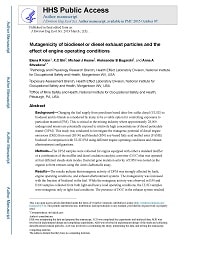Mining Publication: Mutagenicity of Biodiesel or Diesel Exhaust Particles and the Effect of Engine Operating Conditions
Original creation date: March 2013
Authors: E Kisin, XC Shi, MJ Keane, AD Bugarski, AA Shvedova
Changing the fuel supply from petroleum based ultra-low sulfur diesel (ULSD) to biodiesel and its blends is considered by many to be a viable option for controlling exposures to particulate material (PM). This is critical in the mining industry where approximately 28,000 underground miners are potentially exposed to relatively high concentrations of diesel particulate matter (DPM). This study was conducted to investigate the mutagenic potential of diesel engine emissions (DEE) from neat (B100) and blended (B50) soy-based fatty acid methyl ester (FAME) biodiesel in comparison with ULSD PM using different engine operating conditions and exhaust aftertreatment configurations.

- Aerosols and Criteria Gases in an Underground Mine That Uses FAME Biodiesel Blends
- Aerosols Emitted in Underground Mine Air by Diesel Engine Fueled with Biodiesel
- A Computer Software Program that Estimates Air Quantity Requirements in Large Opening Stone Mines
- DEEP Project on Evaluation of Diesel Particulate Filters at Inco's Stobie Mine
- Diesel Exhaust Aerosol, Review of Measurement Technology
- Effectiveness of Iron-Based Fuel Additives for Diesel Soot Control
- The Effects of Water Emulsified Fuel on Diesel Particulate Matter Concentrations in Underground Mines
- Instrumentation for Diesel Particulate Matter Emissions Research
- Mutagenicity of Diesel Exhaust Particles from an Engine with Differing Exhaust After Treatments
- Technology News 514 - The Air Quantity Estimator (AQE): A New Computer Software Tool for Large-opening Mine Ventilation Planning